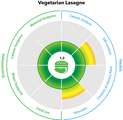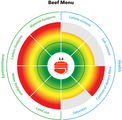Our nutrition patterns are highly resource intensive and are part of the climate killers. A team of the Wuppertal Institute worked on a newly designed tool integrating four indicators in each of the two nutrition-related fields of health and environment, which limits its results to one effect level and makes them easily communicable.
This concept of the so-called Nutritional Footprint is now presented in a paper published in the Journal of Cleaner Production. The methodology has been applied to eight lunch meals, and its calculations procedures are presented in detail.
The results underline the general scientific view of food products; animal-protein based meals are more relevant considering their health and environmental effects. The concept seems useful for consumers to evaluate their own choices, and for companies to expand their internal data, their benchmarking processes, or their external communication performance.
The paper "The Nutritional Footprint - integrated methodology using environmental and health indicators to indicate potential for absolute reduction of natural resource use in the field of food and nutrition" by Melanie Lukas, Holger Rohn, Michael Lettenmeier, Christa Liedtke and Klaus Wiesen is available via ScienceDirect.
Printable pictures

Vegetarian lasagne (source: Wuppertal Institute)

Beef menu (source: Wuppertal Institute)
